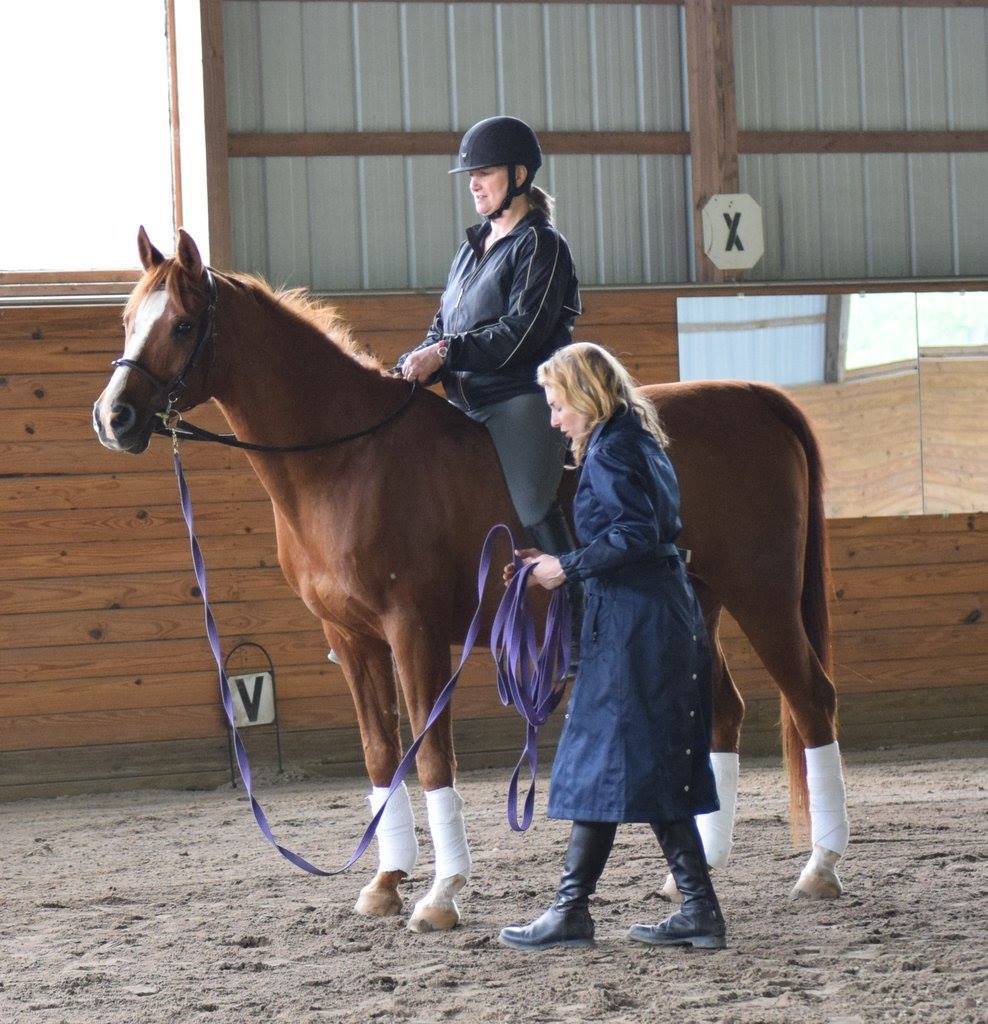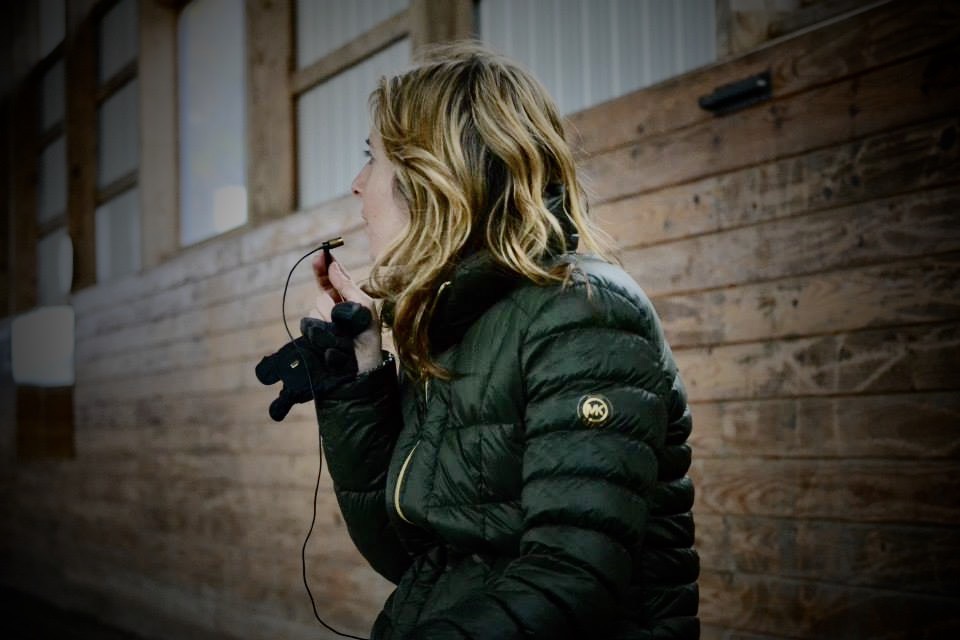It is hard to miss the blonde hair and occasional Greek—
but the most unusual thing about Maria Katsamanis, and about her clinics, is the extraordinary rapport that she establishes with each horse within minutes of introduction. Her philosophy is completely about the horse.
 This article was originally published in Horse News
This article was originally published in Horse News

Her philosophy continues to be completely centered on the mental and physical wellness of the horse. Her approach to each horse is that of creating a partner and not a slave, of nurturing a deep bond where the horse sees the human as a source of comfort and preservation. Here, you will not find a cookie cutter technique.
And Maria is very clear from the start that her approach does not include gadgets, or devices.
This is not a formulaic approach. Hers is of learning to hear the horse, and comes from the heart. And this supported by Classical principles in evaluating the horses readiness for the dance. The foundation arrives largely from Classical Greek and French principles.
 Her clinics typically have a 2- day format. There is a progression that evolves every day and she has found that it takes about two days for horse and human to connect to new learnings. Each of the two days is divided into two sessions: in the morning Maria works with each of the horses, up to six of them, individually lunging and working them in hand before riding them. In the afternoon, the student works with the horse, lunging, work in hand and riding.
Her clinics typically have a 2- day format. There is a progression that evolves every day and she has found that it takes about two days for horse and human to connect to new learnings. Each of the two days is divided into two sessions: in the morning Maria works with each of the horses, up to six of them, individually lunging and working them in hand before riding them. In the afternoon, the student works with the horse, lunging, work in hand and riding.
The lunging and work in hand are the cornerstones of the program. The lunging techniques are unique and address each horse’s individual profile, including their conformation, physical issues and mental blocks. It is through the ground work that the horse discovers for himself the “on the bit“ position. She emphasizes forward energy right from the beginning but never at the expense of loss of balance; forward but not frantic. Work In Hand follows lunging.

Her method is of the 3 S's: strength, suppleness and self carriage, for both the horse and rider.
The lunging/Work in Hand is central to the training process as it allows the horse to learn about being on the bit without rider interference, and it begins each session's work. Beyond the obvious training value, it changes the nature of the horse/rider relationship. It is more intimate and permits the rider to truly see the horse, how he moves, where he is stiff, how he is that day.
 Watching horses and riders over the two days you can see them developing balance and confidence faster than one would think possible. When asked about her goals for horse and rider, Dr. Maria Katsamanis noted:
Watching horses and riders over the two days you can see them developing balance and confidence faster than one would think possible. When asked about her goals for horse and rider, Dr. Maria Katsamanis noted:
I am committed to creating a ride that is happy, forward and without the pushing and pulling that often overshadows the elegance we seek even in the simple parts of our riding
She helps reveal what are potential barriers or blocks to creating natural and relaxed forward energy and to do that without the use of spurs and pushing legs.
Her explanations are simple and the results are real. Hers is not an easily defined formula of aids. It is rather a way of being with the horse that preserves their dignity.
As a teacher, a doctorate in Clinical Psychology gives her a unique way of working with riders. She has a special understanding of people as she does of horses. Connecting horse and rider is paramount to her lessons. While the morning sessions involve her working with the horse, the ultimate goal is for the student to find that complete connection with their mount. Maria’s explanations are clear.
When Science Meets Art to Harness the Ultimate Connection—
She also explains the physiology of each particular horse and what exercises need to be done to improve that horse’s wellbeing and readiness for riding.
A unique feature to her New Jersey clinics is that she often incorporates an Equicizer, an equine simulator, to evaluate and work on rider coordination, balance, general fitness, and timing.
 For some riders, she also uses a computer physiology assessment to provide concrete feedback about their mental readiness for the ride.
For some riders, she also uses a computer physiology assessment to provide concrete feedback about their mental readiness for the ride.
Her explanations are riveting, intriguing, inspiring and remarkably accurate.
By the second day the flow is amazing as both horse and rider realize how little it takes to dance smoothly together. Longtime student, Joanna Dupres says,
Horses transform with her. It’s amazing…but I’ve seen her work over and over and she takes normal everyday horses to look beautiful. She says they are masterpieces. She is right!
In the middle of the day, there is a lunch break followed by the afternoon session when the student receives a private lesson.
 Questions following each ride are encouraged. Maria is remarkably accessible and wants to answer questions rather than give a lecture. Her clinics are not limited to dressage riders. She sees her work as a foundation regardless of discipline. Clinics are open to all levels of riding, breeds and disciplines. Stallions and challenging horses welcomed. To learn more attending a clinic or oganizing one visit https://www.mariakatsamanis.com/events
Questions following each ride are encouraged. Maria is remarkably accessible and wants to answer questions rather than give a lecture. Her clinics are not limited to dressage riders. She sees her work as a foundation regardless of discipline. Clinics are open to all levels of riding, breeds and disciplines. Stallions and challenging horses welcomed. To learn more attending a clinic or oganizing one visit https://www.mariakatsamanis.com/events


